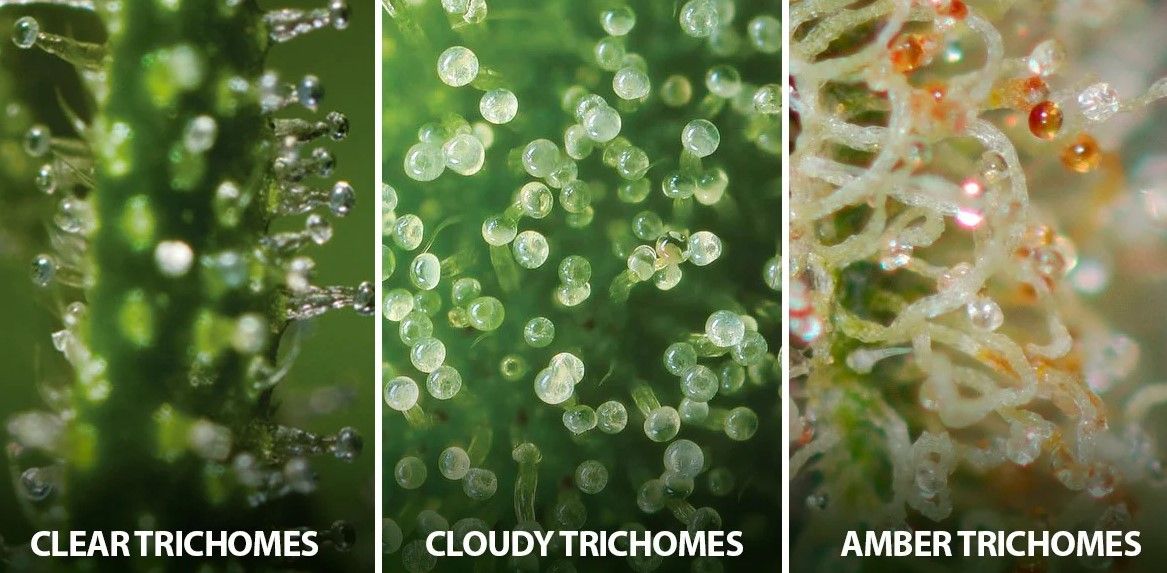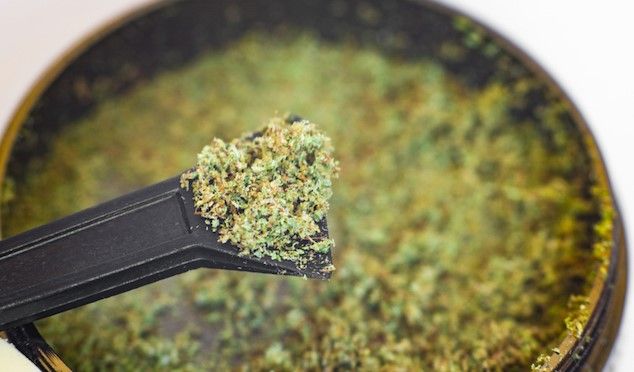Marijuana is finally receiving the attention it has long deserved. Marijuana is now permitted in two-thirds of the United States for medical reasons. It’s also legal to use marijuana recreationally in Canada. As a result, cannabis usage has changed in certain areas.
Since marijuana is a plant that has been used for centuries and continues to be used today, both the general public and new consumers need to understand everything there is to know about it. After all, knowledge is unquestionably powerful. For example, how many people use cannabis medicinally or recreationally? How many of them are aware of the part of the plant responsible for producing intoxication?
Look at the cannabis you’re going to dry in greater detail the next time you come across it that’s nearly finished or just harvested. Do you see those lovely tiny crystals that cover the buds and leaves? They’re known as “trichomes,” which derives from the Greek term for hair growth, trichoma.
The trichomes in marijuana produce the terpenes and flavonoids that give it its distinctive flavor. They also contain the cannabinoids that make cannabis powerful.
Why Do Cannabis Plants Have Trichomes?
 Trichomes provide protection to the marijuana plant. Remember, weed has existed in the wild for tens of thousands of years and has developed defenses. When female plants begin to flower, they are vulnerable to predation by pollinators, animals, and UV radiation.
Trichomes provide protection to the marijuana plant. Remember, weed has existed in the wild for tens of thousands of years and has developed defenses. When female plants begin to flower, they are vulnerable to predation by pollinators, animals, and UV radiation.
Trichomes are a potent deterrent. When a predator like a deer tries to consume the plant, the powerful cannabinoids make them feel intoxicated.
Trichomes have a distinctive pungent and sometimes even nauseating flavor. This keeps most insects and animals away from the plant. Trichomes also prevent fungal growth and strong winds from harming the plant.
Trichomes are the glands that cover marijuana leaves and buds. THC and CBD, as well as over 110 additional cannabinoids, can be found in trichomes. As you know, THC creates the euphoric high that marijuana users seek out. CBD is becoming increasingly popular as a potential solution for medical problems without producing intoxication.
Furthermore, the terpenes produced by trichomes give cannabis its unique fragrances. Terpenes, for example, contribute to the Pineapple Kush strain‘s tropical fruit flavor and fragrance.
Therefore, trichomes may assist you in being stoned and alleviating chronic pain. They also allow you to appreciate the flavor and fragrance of cannabis.
How and When Trichomes Are Produced
Your plant is ready to flower after a few weeks. Trichome development will begin in earnest at this point. On the surface, trichomes appear on the cannabis plant as it begins to produce flowers. They start to move plastids and vacuoles from their stalks in the gland’s head cells. The gland head metabolizes and produces the precursor for cannabinoids, which are cells in the gland head.
Trichomes are the colorful, sticky deposits that cover the leaves and stems of marijuana plants. Trichomes develop at different rates depending on a variety of conditions, such as the growing environment and genetics. Terpenes and cannabinoids do not always correlate with high trichome production.
UV radiation has a major role in the overall terpene and cannabinoid synthesis within the trichome’s head.
Using Trichomes to Determine When to Harvest
 Trichomes are used by marijuana growers to tell when their crop is ripe for harvesting. If the trichomes are clear, it’s not yet time to harvest the plant. The trichomes will have a milky or hazy color when the moment comes. They also frequently have a ‘mushroom’ head.
Trichomes are used by marijuana growers to tell when their crop is ripe for harvesting. If the trichomes are clear, it’s not yet time to harvest the plant. The trichomes will have a milky or hazy color when the moment comes. They also frequently have a ‘mushroom’ head.
The trichomes will turn amber or brown if you wait for too long to harvest. Some of the THC has been converted into CBN at this time. As a result, you are more likely to feel drowsy and calm after smoking it.
However, not all marijuana strains’ trichomes become milky white when ready for harvest. Before you place too much trust in the color of your trichomes, you must understand the characteristics of any strain you cultivate.
Trichomes are quite fragile and volatile at all stages. It doesn’t matter if they’re still on the vine or if the plant has already been harvested. Trichomes can be damaged by heat, light, or oxygen exposure. Furthermore, their potency will deteriorate if you wait too long to cure and dry your cannabis.
Three Types of Trichomes
For the record, three distinct trichome types contain THC, CBD, and all of the other cannabinoids.
1 – Bulbous
The smallest of the three trichome types is this one, which has a diameter of 10-15 microns. For the record, human hair measures around 40 microns in width. On the surface of the entire plant, bulbous trichomes may be found.
2 – Capitate Sessile
The hairs of the plant on these buds are larger and contain more trichomes than their bulbous counterparts. A head and a stalk make up capitate sessile trichomes.
3 – Capitate Stalked
The golden lime trichomes are the biggest and most plentiful of the three. Some of them can reach a diameter of 100 microns or more. This means they may be seen without difficulty with the naked eye. The waxy gland head is where terpene and cannabinoid synthesis takes place, in its waxy gland head.
The capitate-stalked variety is the most common of all three trichomes, producing cannabinoids. They may be seen near the calyxes of budding marijuana plants’ buds. Their massive size implies they also produce the greatest concentration of essential oils.

Can Flushing Increase Trichome Production?
Flushing marijuana plants with ice water has been said to boost trichome development, according to some farmers. You must complete the procedure in the final week or two before harvesting. In general, growers clean their plants to remove surplus nutrients. It helps guarantee that the cannabis doesn’t have a foul fertilizer flavor.
What is the advantage of using ice water? There isn’t any scientific evidence to suggest that it increases the number of trichomes on your plants, but one idea suggests that it is a useful technique for ‘stressing’ them. Furthermore, exposure to lower temperatures inhibits the deterioration of certain terpenes. This may happen at the end of flowering week.
Trichomes – The Home of Potent Concentrates
We are ecstatic in the current era. Marijuana strains with THC levels of over 25 are being developed constantly by breeders. The majority of cannabis sold and consumed in the golden age had far less than 10% THC. We’re not happy with our 25% THC marijuana; we want more! Concentrates such as kief, shatter, and wax contain over 70% THC, which is a level that may shock even experienced smokers. The trichomes, which contain the most cannabinoids, are where most of the THC is hiding. As a result, marijuana users are learning how to remove the sticky THC-rich resin from the rest of the plant.
At-home manufacturing of concentrates including shatter, wax, and oil is possible. To isolate trichomes from the plant, you’ll need a solvent such as butane oil. Butane hash oil (BHO) isn’t safe to make at home. As a result, we propose utilizing concentrates produced by specialists instead. Ice water, alcohol, and the costly CO2 process are other extraction strategies.
When trichomes dry up, you may collect what’s known as “kief” with a three-chamber grinder. Although it isn’t as strong as a professionally prepared concentrate, it still contains 50% or more THC.
It is an exciting and relatively cost-effective way to get kief. It’s also a good emergency supply when you’ve run out of marijuana! Sprinkle it on joints, make a bowl with it, or use it for moonrocks; whatever you do, use it responsibly because it is quite strong.
Final Thoughts on Trichomes
Take a few minutes to appreciate the gorgeous trichomes that develop on marijuana. They also contain the cannabinoids needed to get high, as well as protecting the plant from predators. They also include terpenes, which are responsible for the scent and taste of your cannabis.
If you grow marijuana, be sure to harvest it as soon as possible. You no longer get the advantage of a strong THC high if the trichomes become brown. Trichomes might fall off in some situations, which is terrible. To receive the maximum benefit of marijuana, you must consume as many trichomes as feasible.
To get kief, simply grind the trichomes. It’s a potent type of cannabis that will undoubtedly provide you with the desired intoxicating effects.

